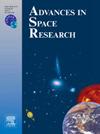射电暴分类器:利用太阳周期 24 最大值期间的物理特性对 CALLISTO 光谱中的太阳射电暴类型 II、III 和 IV 进行自动分类
IF 2.8
3区 地球科学
Q2 ASTRONOMY & ASTROPHYSICS
引用次数: 0
摘要
利用 CALLISTO 光谱仪对太阳射电暴(SRBs)进行全年连续观测会产生大量光谱数据。本研究介绍了一种脉冲串分类器算法,这是一种自动算法,可将 SRB 频谱分为三种太阳射电暴,即 II 型(SRBT II)、III 型(SRBT III)和 IV 型(SRBT IV)。拟议算法的设计使用了从一组训练数据集文件中提取的四个特征参数。这些特征参数是从频谱的频率通道和时间步上观察到的强度脉冲串中提取的。该数据集包括 50 个 SRBT II 和 SRBT III 光谱,以及 40 个 SRBT IV 光谱,收集于 2014 年太阳极大期(太阳周期 24)。在对训练数据集进行观测和分析后,为每种爆发类型设置了阈值。为测试该算法,使用了由 2013 年至 2016 年的 80 个数据光谱组成的训练数据集。使用真阳性(TP)和假阳性(FP)的百分比计算所提出算法的准确性。结果表明,80 个光谱中有 57 个被归类为 TP,23 个被归类为 FP,准确率为 74%。本文章由计算机程序翻译,如有差异,请以英文原文为准。
Burst-classifier: Automated classification of solar radio burst type II, III and IV for CALLISTO spectra using physical properties during maximum of solar cycle 24
Continuous observation of solar radio bursts (SRBs) throughout the year using the CALLISTO spectrometer generates a huge volume of spectral data. This study introduces a burst-classifier algorithm, which is an automated algorithm, to classify the SRB spectrum into three solar radio bursts, namely Type II (SRBT II), Type III (SRBT III) and Type IV (SRBT IV). The proposed algorithm was designed using four characteristic parameters derived from a collection of training dataset files. The characteristic parameters were derived from the intensity bursts observed on frequency channels and timesteps of the spectrum. This dataset consisted of 50 spectra of SRBT II and SRBT III, along with 40 spectra for SRBT IV, collected during the solar maximum of 2014 (Solar Cycle 24). After observations and analysis of the training dataset, each burst type was set up with a threshold. A training dataset of 80 data spectra from 2013 to 2016 was used to test the algorithm. Accuracy of the proposed algorithm was calculated using the percentage of true positives (TP) and false positives (FP). Findings demonstrate an accuracy of ∼74 % with 57 out of 80 spectra classified as TP and 23 spectra as FP.
求助全文
通过发布文献求助,成功后即可免费获取论文全文。
去求助
来源期刊

Advances in Space Research
地学天文-地球科学综合
CiteScore
5.20
自引率
11.50%
发文量
800
审稿时长
5.8 months
期刊介绍:
The COSPAR publication Advances in Space Research (ASR) is an open journal covering all areas of space research including: space studies of the Earth''s surface, meteorology, climate, the Earth-Moon system, planets and small bodies of the solar system, upper atmospheres, ionospheres and magnetospheres of the Earth and planets including reference atmospheres, space plasmas in the solar system, astrophysics from space, materials sciences in space, fundamental physics in space, space debris, space weather, Earth observations of space phenomena, etc.
NB: Please note that manuscripts related to life sciences as related to space are no more accepted for submission to Advances in Space Research. Such manuscripts should now be submitted to the new COSPAR Journal Life Sciences in Space Research (LSSR).
All submissions are reviewed by two scientists in the field. COSPAR is an interdisciplinary scientific organization concerned with the progress of space research on an international scale. Operating under the rules of ICSU, COSPAR ignores political considerations and considers all questions solely from the scientific viewpoint.
 求助内容:
求助内容: 应助结果提醒方式:
应助结果提醒方式:


